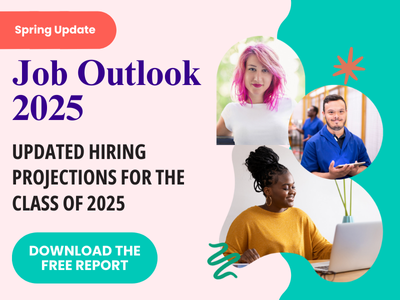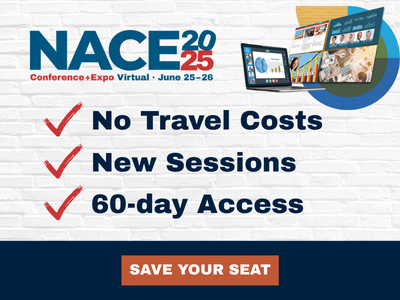NACE Journal, November 2021
Research on the value and impact of participating in undergraduate research, scholarship, and creative inquiry (URSCI) consistently demonstrates significant benefits that transform future prospects for our students. These benefits span traditional measures of student success, such as increasing retention, persistence, and graduation rates; advancements in dispositions and social psychological constructs, such as confidence, ability to work independently and overcome obstacles, and increases in self-efficacy; and learning outcomes, such as growth in written and oral communication skills, critical thinking, and technical skills.1
Importantly, URSCI experiences benefit all students, with disproportionately positive gains for underserved student populations.2 Undergraduate research experiences3 (UREs) transcend disciplines and take place at sites within and beyond institutions of higher education. The models employed are equally varied, including student-mentor dyads, multilayered teams, course-embedded experiences, and community-based and action-oriented projects. Across these experiences, the valuable skills, knowledge, and dispositions gained often appear as employer priorities in making hiring decisions.
In the Council on Undergraduate Research (CUR) 2019 white paper, Undergraduate Research: A Road Map for Meeting Future National Needs and Competing in a World of Change,4 the authors position UREs as a robust tool for achieving workforce needs. Advancing this claim, the 2021 American Association of Colleges and Universities’ (AAC&U) How College Contributes to Workforce Success report5 stated that, of the employers surveyed, 85% were “somewhat” or “much more” likely to consider hiring a candidate with experience in undergraduate research. The report also offers several recommendations for those working in higher education to fill opportunity gaps in meeting workforce demands. Two of these recommendations are instructive as we think about communicating the power and impact of undergraduate research experiences—“mak[ing] mindsets and aptitudes an explicit part of learning, inside and outside the classroom,” and “equip[ing] students to name and reflect upon the skills that matter.” Using the 2021 NACE career readiness competencies as a framework, career services professionals are uniquely positioned to act on the AAC&U recommendations and advance the dialogue set forth in the CUR white paper by mapping UREs to career readiness competencies for the benefit of students, faculty, and employer partners.
Below, I name the eight NACE career readiness competencies and illustrate how UREs build career-ready skills, knowledge, and dispositions using the NACE sample behaviors.6 For competencies where the connections to UREs are more opaque, I offer suggestions for career services professionals to probe aspects of the URE with faculty and students to bring to the forefront the competencies developed.
Competency: Career & Self-Development
When given the opportunity to reflect on their UREs, students share the valuable impact of the experience on their career and personal development.7 Because the process of UREs is the “doing of the disciplines” without pre-determined outcomes, students are called upon to ignite their curiosity, “seek out opportunities to learn,” and “assume duties or positions that will help one progress professionally.”
Embedded in the URE process is new learning in the form of the skills, knowledge, and dispositions gained to support one’s career aspirations. This, for example, could take the form of formal activities, such as earning IRB certification, writing grant proposals, learning to use industry software, developing portfolios, engaging in public performances, and curating exhibits or showings.
The process of engaging in UREs is also a means of developing one’s professional identity.8 As students participate in UREs and interact with the ideas, techniques, questions, and, importantly, with mentors, peers, teammates, and stakeholders, professional identities are formed, moving participants from student to teacher, healthcare professional, printmaker, data analyst, survey researcher, chemist, and so forth.
Competency: Communication
Communication is a core positive outcome associated with participation in UREs.9 Developing the skill of asking questions is a hallmark of the URE process of discovering new knowledge generally, and specifically in seeking “guidance with assigned tasks.” Helping students frame and share their work with varied audiences “in a clear and organized manner so that others can effectively understand” is a critical component of UREs in both the process of conducting the work as well as in its dissemination.
The products of UREs come in many forms, ranging from the formal to the informal, including performances, publications, presentations, posters, portfolios, exhibits, proposals, abstracts, business plans, case studies, research questions, and more. Many institutions host research symposiums, forums, or other celebratory dissemination events created for students to showcase their work. Through participation in these events, students gain experience sharing their work in a formal setting outside the classroom verbally, visually, and in written form, typically to lay audiences outside of their field of study.
Competency: Critical Thinking
Critical thinking is another essential competency built through participating in UREs and appears consistently as a positive outcome in the literature.10 Practicing the skills of observation, analysis, interpretation, inference, and problem-solving cuts across the various types of undergraduate research, scholarship, and creative inquiry. The journey itself calls students to “gather and analyze information from a diverse set of sources and individuals to fully understand a problem,” “make decisions and solve problems using sound, inclusive reasoning, and judgement,” and “accurately summarize and interpret data with an awareness of personal bias that may impact outcomes.” Consider, for example, the critical thinking skills involved in developing and disseminating a survey to gather attitudinal information, systematically collecting and analyzing water samples from a stream, creating a life-sized replica of a dinosaur, or collaborating with an interprofessional team to develop a coordinated care plan.
Competency: Equity & Inclusion
Demonstrating “flexibility by adapting to diverse environments” and keeping “an open mind to diverse ideas and new ways of thinking” are competencies embedded in the undergraduate research process.
Community-based and action-oriented undergraduate research experiences also often help students “solicit and use feedback from multiple cultural perspectives to make inclusive and equity-minded decisions” and “actively contribute to inclusive and equitable practices that influence individual and systemic change.”11
While critical URE approaches put social justice at the forefront (such as critical feminist and critical race theories and methods), undergraduate research experiences do not always center equity and inclusion or interrogate the existing systems that create and perpetuate inequities. In the last few years, however, a shift to developing an awareness, attitude, knowledge, and skills related to equity and inclusion has moved more to the center in many places, including undergraduate research, scholarship, and creative inquiry. This shift can be seen, for example, in a 2018 themed issue of CUR’s flagship journal, Scholarship and Practice of Undergraduate Research, subtitled “Leveraging Undergraduate Research to Foster Diversity and Achieve Equity,” with articles focused on theory, assessment, practice, and vignettes. More recently, in July 2021 CUR hosted a conference themed on centering diversity, equity, and inclusion in undergraduate research, scholarship, and creative activity.
Clearly, there is interest in building capacity for this competency. Before we can expect our students in UREs to “identify resources and eliminate barriers resulting from individual and systemic racism, inequities, and biases,” or “address systems of privilege that limit opportunities for members of historically marginalized communities,” mentors need to develop competencies in these areas and enact an equity-minded approach to their work. To the degree that mentors center equity in their approach, work to build diverse teams, focus on creating an inclusive climate, and interrogate URE practices and systems, we will begin to see the this competency become more consistently embedded across UREs. Asking students and faculty about the social justice impact of their work can offer insight into the equity and inclusion competencies embedded.
Competency: Leadership
Leadership as an outcome of UREs has not been as explicitly assessed as the other NACE competencies. Some elements of leadership are demonstrated through engaging in the undergraduate research process, such as “seek out and leverage diverse resources and feedback from others to inform direction,” “use innovative thinking to go beyond traditional methods,” “plan, initiate, manage, complete, and evaluate projects,” and “use innovative thinking to go beyond traditional methods.”12
Other aspects of leadership, however, are explicitly revealed in the structure of URE models or the type of URE. For example, in models that include peer mentors or tiered teams, students serve as role models and have the opportunity to “inspire, persuade, and motivate self and others under a shared vision.” Where the URE includes community-based or client-based projects, engagement with these external partners creates the platform to demonstrate leadership competencies.13 Asking students and faculty to describe their URE team and connections with stakeholders can help tease out leadership skills developed through these experiences.
Competency: Professionalism
Facets of professional competencies repeatedly appear in the literature as positive outcomes from engaging in UREs.14 These competencies are most easily visible in student interactions with stakeholders. Interacting with mentors, teammates, community or industry partners, clients, and other stakeholders builds skills in demonstrating dependability and accountability; ability to meet deadlines, act independently and with confidence; ability to work through ambiguity and obstacles; ability to prioritize and accomplish tasks; and a commitment to a larger, external goal.
Competency: Teamwork
The literature is replete with examples of teamwork competencies as a positive outcome from participating in UREs.15 These examples span the various URE models, from dyad apprentice models to tiered teams to course-based experiences as well as across the disciplines and UREs with external partners. At its core, UREs are a relationship; “be[ing] accountable for individual and team responsibilities and deliverables,” “collaborat[ing] with others to achieve common goals,” effectively managing conflict and “build[ing] strong, positive working relationships” are all competencies developed by engaging in this relationship. Consider examples such as a group writing and performing a play, an emergency management team running a table top exercise, or an individual working with a client to build a business plan. By asking students and faculty to describe the structure of the UREs, career services professionals can better understand the teamwork competencies built through the experience.
Competency: Technology
The development of technology competencies often appears in the URE literature in phrases such as lab techniques, technical skills, data analysis skills, and others.16 “Quickly adapting to new or unfamiliar technologies,” “manipulat[ing] information, construct[ing] ideas, and us[ing] technology to achieve strategic goals,” and “identify[ing] appropriate technology for completing specific tasks,” and “manag[ing] technology to integrate information to support relevant, effective, and timely decision-making” are all part the URE process.
Additionally, and accelerated by the pandemic, is leveraging technologies for teams to interact across distances. Many undergraduate research, scholarly, and creative teams found paths forward to continue their work by leveraging collaborative virtual technologies, such as web conferencing, digital whiteboards, shared workspace platforms, document management, chat and discussion forums, and others. Asking students and faculty to talk about the techniques used in gathering, synthesizing, and analyzing information can reveal technology competencies gained.
Benefitting All
To the degree that we align relevant stakeholders in the use of the NACE career readiness competency framework to make meaning of UREs, all will benefit.
- Faculty can learn to transparently articulate and frame the skills, knowledge, and dispositions students gain in UREs so that students can see the transferable nature of their experiences.
- Students can learn to frame and tell their stories in ways that potential employers can receive and understand.
- Employer partners can gain a better understanding of the value of UREs and leverage the impact of these experiences that incoming employees bring to their enterprises.
- Career services professionals can serve as key facilitators in this conversation by more deeply understanding the nature and content of UREs, helping faculty and students think through their framing and messaging, and translating and contextualizing these experiences for potential employers.
Endnotes
1 See for example:
Brownell, J.E., and L.E. Swaner. 2010. Five High-Impact Practices: Research on Learning Outcomes, Completion, and Quality. Washington, DC: Association of American Colleges and Universities.
Ishiyama J.T. 2002. Does early participation in undergraduate research benefit social science and humanities students? Journal of College Students. 36: 380-386.
Kuh, G.D. 2008. High-Impact Educational Practices: What They Are, Who has Access to Them, and Why They Matter for All Students. Washington, DC: Association of American Colleges and Universities.
Lopatto, D. 2003. The Essential Features of Undergraduate Research. CUR Quarterly 24: 139-142.
Osborn, J. M. and K. K. Karukstis. 2009. The benefits of undergraduate research, scholarship, and creative activity. In: M. Boyd and J. Wesemann (Eds.), pages 41-53, Broadening Participation in Undergraduate Research: Fostering Excellence and Enhancing the Impact. Council on Undergraduate Research, Washington, DC.
2 See for example:
Brownell, J.E., and L.E. Swaner. 2010.
Gregerman, S.R. 2009. Filling the gap: The role of undergraduate research in student retention and academic success. In M. Boyd and J. Wesemann (Eds.), pages 245-256, Broadening Participation in Undergraduate Research: Fostering Excellence and Enhancing the Impact. Council on Undergraduate Research, Washington, DC.
3 I use both the more inclusive phrase undergraduate research, scholarship, and creative inquiry (URSCI) to capture the breadth of scholarly and creative activities across and transcending disciplines, as well as the more succinct term undergraduate research that is more commonly found in the literature. The concise phrase, undergraduate research experiences, is meant to be inclusive of scholarly and creative endeavors as well.
4 Altman, J.D., T-M. Chiang, C.S. Hamann, H. Makhluf, V. Peterson, and S. E. Orel. 2019. Undergraduate Research: A Road Map for Meeting Future National Needs and Competing in a World of Change, CUR White Paper No. 1. CUR, DC.
5 Finley, Ashley. 2021. How College Contributes to Workforce Success: Employer Views on What Matters Most. Association of American Colleges & Universities: DC.
6 The sample behaviors associated with the career readiness competencies can be found at www.naceweb.org/career-readiness/competencies/career-readiness-defined/.
7 See for example:
Hunter A-B, S.L. Laursen, E. Seymour. 2006. Becoming a scientist: The role of undergraduate research in students’ cognitive, personal, and professional development. Science Education. 91:36-74.
Picardo, K. and K. Sabourin. 2018. Measuring Student Learning Gains in Independent Research Experiences in the Sciences Through Reflective Practice and ePortfolios. Bioscene. 44,2: 29-36.
8 See for example:
Palmer, R. J., A.N. Hunt, M.R. Neal, and B. Wuetherick, 2018. The Influence of Mentored Undergraduate Research on Students' Identity Development. Scholarship and Practice of Undergraduate Research, 2, 2: 4-14.
Slobodzian, J.T., and N. Pancsofar. 2014. Integrating Undergraduate Research Into Teacher Training: Supporting the Transition from Learner to Educator. CUR Quarterly 34,3: 43-47.
9 See for example:
Kistner, K., E.M. Sparck, A. Liu, H. W. Sayson, M. Levis-Fitzgerald and W. Arnold. 2021. Academic and Professional Preparedness: Outcomes of Undergraduate Research in the Humanities, Arts, and Social Sciences. Scholarship and Practice of Undergraduate Research. 4,4: 3-9.
Stanford, J.S., E. Suzanne, K. Rocheleau, P.W. Smith, and J.Mohan. 2017. Early Undergraduate Research Experiences Lead to Similar Learning Gains for STEM and Non-STEM Undergraduates. Studies in Higher Education 42,1: 115-129.
10 See for example:
McLaughlin, J. S. M. Patel, and J. B. Slee. 2020. A CURE Using Cell Culture-Based Research Enhances Career-Ready Skills in Undergraduates. Scholarship and Practice of Undergraduate Research,
4,2: 49-61.
Osborn, J. M. and K. K. Karukstis. 2009.
11 See for example:
Friedman, J. and L. Graham. 2018. A Kitchen Table Pedagogy for Interrogating Whiteness through a Research Experience Course, Sociology of Race and Ethnicity, 41:1, 142-153.
Ray, R. 2016. #BlackLivesMatter at UMD: Community-based Participatory Research to Create a More Equitable America, Footnotes, 44:6, 12,15.
Smedley-Lopez, A. C., Johnson, H. R., and A. Amarante. 2017. SLICES: Critical Theory as Praxis and Research-Based Service Learning, Humboldt Journal of Social Relations, 39:39, 176-191.
12 See for example:
Osborn, J. M. and K. K. Karukstis. 2009.
13 See for example:
Cuthbert, D., D. Arunachalam, and D. Licina. 2012. ‘It feels more important than other classes I have done:’ an ‘authentic’ undergraduate research experience in sociology,
Studies in Higher Education, 37:2, 129-142.
Shanahan, J.O., E. Ackley-Holbrook, E. Hall, K. Stewart and H. Walkington. 2015. Ten Salient Practices of Undergraduate Research Mentors: A Review of the Literature, Mentoring & Tutoring: Partnership in Learning, 23:5, 359-376.
14 See for example:
McClure-Brenchley, K., K. Picardo, and J. Overton-Healy. 2020. Beyond Learning: leveraging Undergraduate Research into marketable Workforce Skills. Scholarship and Practice of Undergraduate Research, 3:3 28-35.
Petrella John K. Alan P. Jung 2008. Undergraduate Research: Importance, Benefits, Challenges. International Journal of Exercise Science, 1:3, 91-95.
Ward, Christine, Joan S. Bennett, and Karen W. Bauer. 2003. “Content Analysis of Undergraduate Research Student Evaluations.” Unpublished report available as of May 2003 at http://www.udel.edu/RAIRE/Content.pdf.
15 See for example:
McClure-Brenchley, K., K. Picardo, and J. Overton-Healy. 2020.
Seymour E, A-B. Hunter, S.L. Laursen, T. DeAntoni. 2004. Establishing the benefits of research experiences for undergraduates: First findings from a three-year study. Science Education, 88:493-534.
16 See for example:
Picardo, K. and K. Sabourin. 2018.
Seymour E, A-B. Hunter, S.L. Laursen, T. DeAntoni. 2004.
Ward, Christine, J. S. Bennett, and K. W. Bauer. 2003.







